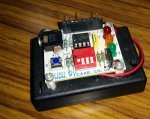' Demonstration of open-loop style of programming, allowing multiple 'tasks' to be handled
' Also demonstrates the Max command: sometimes difficult for the beginner to understand.
'
'What it does: (Exercise: draw a flow diagram - use a large sheet of paper)
' * At startup, emits a musical trill sound
' * While turned on but not in use, emits a 'tick' sound every few seconds.
' * The pushbutton switch, if pressed momentarily, will toggle the Yellow LED on and off.
' * If the switch is held a little longer (>400mS), the green LED flashes quickly: this
' indicates that an intermediate time has expired, affecting how the Yellow LED behaves.
' * Then, if the switch is released, the yellow LED flashes.
' * Pressing the switch again briefly turns the Yellow LED off.
' * If the switch is held for an extended time (>4 seconds), the Red LED is turned on.
'
'Tested on PICAXE 08M firmware 9.1 (AXE-092 Board)
' Revision History
' 30-Nov-2006 80 bytes Written by inglewoodpete
' 06-Apr-2011 80 bytes Revised presentation, renamed variables/constants
' 07-Oct-2011 94 bytes Added timer limit indication (Red and Green LEDs)
' 19-Feb-2011 120 bytes Added startup trill and battery-saving 'reminder' tick
'
'***** Definitions *****
'
#PICAXE 08M
' Variables - byte variables are prefixed with 'b'; words with 'w'
'
Symbol bSwTime = b0
Symbol bLEDState = b1 '0 = off, 1 = on, 2 to 255 = flash
Symbol bReminder = b2 'Battery saver: reminder that the AXE092 is turned on!
'
' Hardware - outputs are prefixed with 'o'; inputs with 'i'
'
Symbol oRedLED = 0 'Indicator: Timer has maxed out
Symbol oYellowLED = 1 'Indicator: Result
Symbol oGreenLED = 2 'Indicator: Input Timer
Symbol oBeeper = 2 ' -pin 2 is shared with piezo 'alarm'
Symbol iSwitch = Pin3 'Input
'
' Constants - constant definitions are prefixed with a 'c'
'
' Logical Conditions
Symbol cActive = 1 'Can be 0 or 1
' Counter Values
Symbol cLongPress = 40 'Discrimination between short and log press
Symbol cHalfTime = 10 'LED Hi-Lo transition
Symbol cFullTime = 20 'LED Lo-Hi. Must not be > 254
Symbol cNoteTime = 7 'Duration of startup notes
Symbol cGap = 4 'Duration of gaps between notes
'
'***** End Definitions *****
'************************************************************************
'***** Begin Program *****
'
'***** Initialisation *****
Init:
Sound oBeeper, (50,cNoteTime,0,cGap,70,cNoteTime,0,cGap,90,cNoteTime,0,cGap,120,cNoteTime)
'
'***** Begin Main Loop *****
Do
bSwTime = 0
Low oRedLED
Low oGreenLed
'This Do loop will be bypassed if switch not pressed
Do While iSwitch = cActive 'Determine the time that the switch is pressed
Pause 10 'Only ever use small delays
bSwTime = bSwTime Max 254 + 1 'Max prevents overflow
If bSwTime = 255 Then 'Indicate that timer has maxed out
High oRedLED
ElseIf bSwTime > cLongPress Then
Toggle oGreenLed
EndIf
Gosub HandleFlash 'Maintain flashing if required while button held down
Loop 'Remain in loop while switch pressed
Pause 10 'Only ever use small delays
'Process any switch press
If bSwTime > cLongPress Then
'Start LED flashing
bLEDState = 2
High oYellowLED
ElseIf bSwTime > 0 Then 'Short press
'Turn LED On or Off (Off also stops flashing)
If bLEDState = 0 Then 'Off: so turn LED on
bLEDState = 1
High oYellowLED
Else 'Turn off
bLEDState = 0
Low oYellowLED
Endif
Else 'Ie. bSwTime = 0 for when the button is not pressed
Inc bReminder 'The 'Reminder' counts from 0 to 255 each loop
If bReminder = 0 Then ' then the counter "rolls over" to zero
PulsOut oBeeper, 10 'When bReminder = 0, output a "tick" sound
EndIf
EndIf
Gosub HandleFlash
Loop
'
'***** Subroutines *****
'
HandleFlash: If bLEDState > 1 Then
'Flash control required only for range 2 to 255
Select Case bLEDState
Case > cFullTime
'Cycle complete: Flash the LED back on again
High oYellowLED
bLEDState = 2 'Reset counter to minimum
Case > cHalfTime
'Half time of the flash cycle: reset the LED
Low oYellowLED
EndSelect
Inc bLEDState
EndIf
Return
'
'***** End Of Program *****

